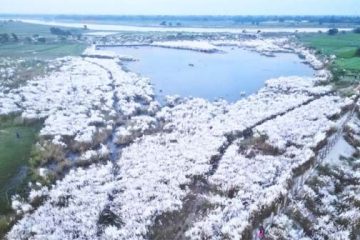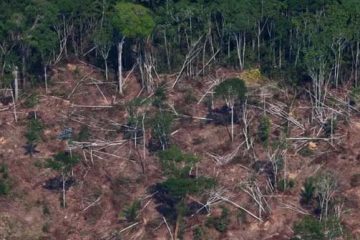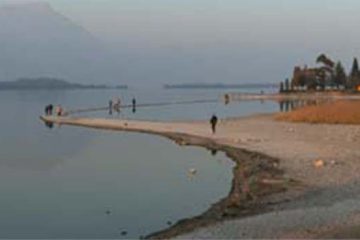Dr. Md. Mizanur Rahman for The Daily Star
 Forest ecosystem provides benefits that support the livelihoods of countless human beings. Forests provide a number of components to the broad range of ecological services such as, regulation of rainfall and hydrological system; maintenance of soil quality, control of soil erosion, modulating climate; and being the habitat of biodiversity. Forests form the basis of different industries e.g. timber, wood processing, paper, rubber, paints, resin, gum, honey, food, medicines, building material, fodder, game, tourism, etc. Forests are home to millions of people all around the world and they are dependent on the forests for their survival.
Forest ecosystem provides benefits that support the livelihoods of countless human beings. Forests provide a number of components to the broad range of ecological services such as, regulation of rainfall and hydrological system; maintenance of soil quality, control of soil erosion, modulating climate; and being the habitat of biodiversity. Forests form the basis of different industries e.g. timber, wood processing, paper, rubber, paints, resin, gum, honey, food, medicines, building material, fodder, game, tourism, etc. Forests are home to millions of people all around the world and they are dependent on the forests for their survival.
Every nation has strong cultural and spiritual attachments to forests. Aesthetics and beauty are the important components of forest services. These services are connected and sustained through the integrity of the ecosystems. It is quite impossible to compare the importance of the various services provided by forests as there is no universally accepted common metric that can be used in such measurement.
Global warming: Climate change and forests are interlinked. The increased destruction of the rainforest forming a precious cooling band around the Earth’s equator, is recognised as one of the main causes of climate change. Forests trap and store carbon dioxide, playing a major role in mitigating climate change. On the flip side of the coin, forests become the sources of the greenhouse gas, carbon dioxide when destroyed or over-harvested and burned. Forests , if not harmed ensure that they are enabling to continue to produce the benefits; to mitigate the effects of a changing climate; and to compensate for fossil fuel emissions through carbon storage; and to enhance ecosystem health, sustainability, and resilience.
Forests reduce greenhouse gas emissions to combat global warming. 20% of global greenhouse gas emissions result from deforestation and degradation of forest, more than all the world’s cars, trucks, ships and planes combined. Fossil fuels release carbon dioxide into the atmosphere contributing to global warming and climate change. Forest alleviates this change by converting carbon dioxide to carbon during photosynthesis. The world’s forests contain about 125 percent of the carbon found in the atmosphere. This carbon is stored in the form of wood and vegetation through “carbon sequestration”.
Trees possess about 20 percent carbon by weight and biomass of forest acts as a “carbon sink.” The soil organic matter produced by the decomposition of dead plant material also acts as a carbon store. Consequently forests store enormous amount of carbon: in total, the world’s forests and forest soils currently store more than one trillion tons of carbon, twice the amount found floating free in the atmosphere, according to FAO studies.
The atmospheric carbon dioxide concentration in the pre-industrial era was 280 ppm. Right now the level has risen to 375 ppm, a 30% increase. It is predicted that the level will be 450 ppm in 2050 resulting in 1.8-3ºC increase in temperature eventually. Therefore, global warming will produce a sharp upswing followed by a deep plunge into a glacial period several thousands years from now. A myriad of potential impacts such as increased cyclone intensity; melting of polar iceberg and glaciers; increased salinity and changes in oceanic currents sea level rise and inundation of low lying cities like Venice, Cairo, New Orleans, Lagos, Amsterdam, etc.; coral bleaching and mortality of coral reef; colonization of invasive species and species migration; changes in ecosystem; mass extinction; ozone layer depletion; water shortage; and spreading of diseases — is predicted.
Biodiversity loss: The oceanic food chains may be disrupted. The Amazonian rainforests will be converted into Savanna. The unique biodiversity of various mega hotspots is being lost on a scale that is quite unprecedented. Even though tropical rainforests occupy just 6 percent of the surface area of the Earth, about 80-90 percent of the entire species of the world exist here. Due to massive deforestation, about 50 to 100 species of animals are being lost each day. Rapid deforestation in the Himalayas leads to the extinction of hundreds of plants and dozens of birds and animal species. It is predicted that 366 plant species as well as three dozen species of birds, fish and mammals could become extinct in this region. The future of Himalayas looks very bleak.
Riparian habitat complexity: Water temperature regulates the physiology and ecology of different like littoral and lentic biota. It influences the distribution, behaviour and survival of biota. Riparian deforestation causes the increase of water temperature, thermocline deepening, habitat complexity and insulation, and decreases littoral shading. This deforestation also increases the down-slope salinity and nitrate contamination in surface runoff. The riparian deforestation causes habitat destruction of wildlife refuges especially of amphibians and reptiles.
Changes in climatic pattern: Plant absorbs water from soil through roots and releases it into the atmosphere during transpiration. This released water then forms clouds and rains. African Congo basin deforestation has claimed an enormous toll through the ages in environmental damage. Deforestation of Amazonian rainforests may change the climatic pattern of the world. The deforestation of Amazon is rising very sharply. Even Bolivian Amazon’s deforestation rate in Santa Cruiz is alarming. 20% of the planet’s oxygen is produced by rainforests.
Soil properties: Deforestation exposes the forest soil to the sun, making it very dry and eventually, infertile, due to volatile nutrients such as nitrogen being lost. The rainfall washes away the rest of the nutrients, which flow with the rainwater into waterways. The soil stands totally devoid of essential nutrients. Large tracts of land will be rendered permanently impoverished due to soil erosion. Deforestation causes drought and desertification. Deforestation disrupts the regulation of the flow of water. It also increases salinity in the soil. It alters the microclimate of a place thus affecting the habitats of endemic species. Tree roots bind the underlying bedrock. Deforestation increases the risk of landslide.
Invasive species: Both climate change and invasive species are highly correlated. They are the extraordinary ecological challenges to the world today. Global warming has a profound influence on species’ geographical ranges. Climate change alters destination habitat and increases vulnerability to invasion because of resource scarcity and increased competition among native fauna and flora. Changes in precipitation, nitrogen deposition and temperature will have tremendous impact on the geographic ranges of many species. Increased temperature will allow the spread northward of some species currently restricted in their northern ranges. Stressed ecosystems facilitate the successful invasion of non-native plants.
Cyclone: Deforestation exacerbates cyclonic impacts. Forests act as a buffer between the cyclone and the habitat area. The impacts of the cyclone Nargis was devastating due to deforestation of the mangroves of the Irrawaddy Delta, Myanmar. Hurricane Mitch devastated the Central American countries of Nicaragua and Honduras. The destructions were so severe due to deforestation. Amazon basin level drops in Peru due to hurricanes and deforestation. The Caribbean will be vulnerable to increased hurricane activity if deforestation of the Amazon rainforest is not stopped. The massive deforestation of the Sundarbans will expose the entire southern part of Bangladesh to frequent cyclones.
How to combat the climate change impacts?
Carbon balancing
Initiating tree-planting projects specifically designated for carbon-emissions mitigation
o Replacing construction materials such as plastics, aluminum or cement with wood
o Initiating carbon finance
o Using more wood in long-lasting products to keep trapped carbon out of the atmosphere for longer periods of time
o Substituting fossil fuels with biofuels
o Implementing the Climate Convention and the Kyoto Protocol in the forest industry
o Calculating the greenhouse gas balance of the forests, on the basis of the amount of deforestation and reforestation and providing the data for the inventory of greenhouse gases
Silvicultural management
o Devising the basic requirements for near-natural silviculture
o Monitoring the impact of climate change on forests and devising appropriate strategies
o Dealing with biotic damage in forests like infestation of wood-boring beetles and forest fires
o Coordinating national and international forest policy
o Improving land use pattern and protecting forest lands
o Involving indigenous peoples and traditional communities in conservation programme
o Introducing aforestation and reforestation with Introducing pioneer and early successional species
o Facilitating natural regeneration in degraded forests
o Leaving denuded forest lands untouched for 20 years to promote natural succession
o Stopping further clear felling and illegal logging
o Protecting natural regenerations (seedling, sapling and juvenile trees) from cutting
o Taking effective actions against encroachers and land grabbers
o Increasing basic research on the impact of forest degradation
o Alleviating poverty in the adjacent areas of forests
o Emphasizing on community based conservation
o Establishing more protected areas
o Searching for alternative fuel sources in the forest and adjacent areas
o Taking care of secondary and successional forests
Riparian forest management
o Declaring riparian vegetation as the refuge ecosystem for plant and wildlife
o Prohibiting clearance of wood and shrubs within 25 m on both sides of any waterway
o Preserving not only the river front, interior and riparian forest edge but also parts of the adjacent upland forest
o Undertaking aforestation on the open sand dunes by the plant species which have ‘prop roots’ to anchor itself in the loose sand
o Maintaining at least two canopy layers (bimodal or reverse J-shaped diameter distribution)
o Maintaining at least two main canopy tree species suited to the sites
o Undertaking passive management to develop tree size canopy structure and decadence
o Planting large diameter trees with strong root systems to provide critical structure
Coastal forest management
o Designing and establishing sea-level / climate modelling network
o Integrating coastal and marine management
o Conducting coastal vulnerability and risk assessment
o Initiating community based coastal forestation
o Introducing afforestation and reforestation by salt tolerant species
Controlling invasive species
o Introducing desirable trees to shade out regeneration of invasive species
o Digging out and burning the thickets of the invasive species
o Using microbial and other biological agents to control invasion
Dr. Md. Mizanur Rahman, a biodiversity specialist, is UNO, Mongla, Bagerhat (mizan_peroj @yahoo.com)





